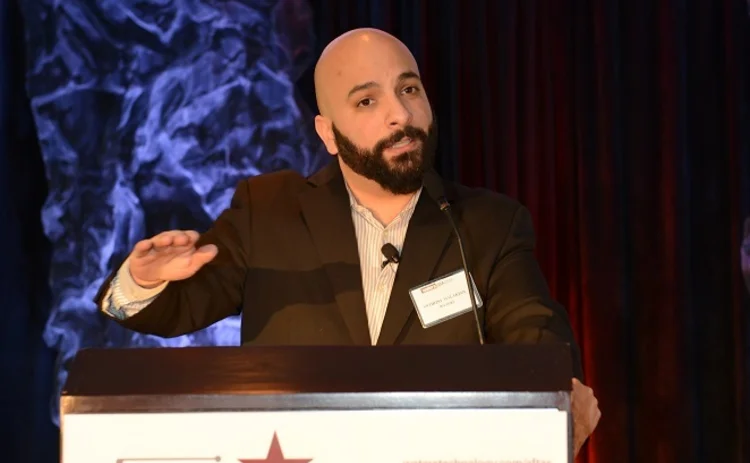When Cyber Crime Becomes Cyber Hype
A headline-grabbing hack may be a bit overblown.

When the first deadline for Form PF came rolling down the pike in 2012, most every vendor that geared itself toward the buy side launched aggressive marketing pushes touting their wares as being the tool that could help conquer this new requirement that stemmed out of the Dodd-Frank Act.
In 2013, vendors focusing on banks jumped onto the Basel III credit valuation adjustment (CVA) bandwagon to spread the good word about their risk modeling and risk analytics tools. A new term of art—XVA—was eventually born.
Last year, the investment book of record (IBOR) took hold amongst large asset managers and a sea of vendors began distributing information about their IBOR capabilities.
This is not to say that all of these vendors were full of it ─ most were simply seizing on a new challenge to market a product that they fully believe in. That's fair. But other vendors were simply slapping lipstick on a pig. More accurately, you can put a Porsche body on a $15,000 starter car, but if there's no a twin-turbo engine underneath then while it may look like a high-end sports car, it won't perform like one.
Now we're on to cybersecurity. And the hype ─ some might say, fear-mongering ─ has been impressive.
Let's start this discussion with the acceptance that cybercrime is the one of the most-challenging issues facing financial institutions, if not the most-challenging. ...But the headlines are getting ahead of the actual damages.
What, Exactly Happened?
Don't get me wrong, cybersecurity may just be the most important, challenging issue facing financial IT today, but when it comes to financial services and, specifically, the capital markets, there's been a tendency to blow events out of proportion. At least that's my opinion.
Last week, my colleague Dan DeFrancesco looked at the massive Carbanak cybergang hack that made the front page of the venerable New York Times.
The article sited Russian security vendor Kaspersky Lab as saying that an unknown number of hackers may have infiltrated over 100 banks and various other financial institutions across 30 nations, stealing in excess of $300 million ─ and possibly three-times that amount, according to the NYT article.
That is eyebrow-raising stuff, right there, especially when it's written on the front page of the Times.
BUT IT'S ONLY A MATTER OF TIME!
Again, let's start this discussion with the acceptance that cybercrime is the one of the most-challenging issues facing financial institutions, if not the most challenging. I've talked with enough CTOs, CISOs and CIOs to not belittle the issue.
But the headlines are getting ahead of the actual damage, or in the very least not being very clear about context. The article says that "the group impersonated bank officers, not only turning on various cash machines, but also transferring millions of dollars from banks in Russia, Japan, Switzerland, the United States and the Netherlands into dummy accounts set up in other countries."
The problem here is that there is no proof whatsoever that money was actually hacked out of a US bank, nor any bank residing in Western Europe. (If proof is ever presented, I'll take back these words.)
Dan spoke with Chris Doggett, who is the managing director of Kaspersky's North American branch, and Doggett said that at least three dozen US banks were targets of the attack, but he couldn't say how many of those banks were successfully breached due to "non-disclosure agreements and ongoing investigations," which is also what the organization told the Times.
Dan also spoke with Bill Nelson, CEO of the Financial Services Information Sharing and Analysis Center (FS ISAC), a group comprised of over 5,000 financial firms that shares and analyzes cyber attacks. He said that this attack was "old news" and that the group has known about the attack for months. Nelson said that no banks in the US or Western Europe have been affected, with most of the targets being Russian banks.
"Yes, some of these banks were scanned, but they successfully defeated it. They weren't breached and for me, it's not a story," Nelson told Dan.
Headline Problems
For the November issue of Waters I profiled Neuberger Berman chief information security officer Bob Ganim about the dangers that lurk in increasingly internet-dependent markets.
He noted that one of the toughest aspects of his job is the fact that every hack and every newly discovered vulnerability makes the front pages of national papers, which, in turn, leads to questions from the CEO and various other business leaders, board members and even investors.
The scale of Ganim's job can be daunting. Neuberger Berman has an office in Dallas-Ground Zero for the Ebola scare in the US. It also has an office in Hong Kong, where the protests for election reform with China have unfolded. And when your job involves information security, every hacker headline is a major concern, since client information is an asset manager's lifeblood. The Shellshock bug was just the latest threat.
"That Thursday, I was involved with every headline in the newspaper as both a CISO and global head of BCP. ...We must be ready for anything," he said.
But he also noted that you can't freak out at every threat and every headline:
"Don't make the mistake of feeling so overwhelmed that you just throw your hands up in the air and ask, ‘Why bother?' Don't make the mistake of being so rigid and controlling with policies to the point that it might impede your organization's ability to do what they do best-and that is to serve your clients," he says. "The most resilient, successful organizations will be the ones that are both realistic and proactive regarding the threats and risks that might leave their organization vulnerable."
Wanted: Partner, not a Promoter
Let me say that Kaspersky is well-respected and no one has ever bad-mouthed them to me. This is not a hit piece against that firm, because there clearly was a hack that led to lost money.
This is more generally aimed at the security-vendor industry, because I get A LOT of press releases with bold-faced headlines, and here's what I believe: While you might win a good deal of early business by crying that the sky is falling after every attempted hack or new vulnerability, eventually firms are going to stop listening. The boy who cried wolf, and all that.
Be proactive, but be a partner. Don't embellish...the threat is real and scary enough, as it is.
To finish, this whole ordeal reminded me of an episode of the animated-comedy, "Archer", which is one of the greatest television shows ever. (That's a fact, not hyperbole or opinion.)
Here's the synopsis of the episode:
Tired of his colleagues constantly calling him a failure, [one of the central characters] Cyril agrees to help George Spelvin, a mysterious computer security expert, inject a pirate virus into the ISIS [not the terrorist organization, but the name of the CIA-like security outfit, that has since changed its name] mainframe so Cyril can defeat the virus and be seen as a hero. Not surprisingly, the plan goes awry.
Basically, this whole article was just an excuse for me to link to this one great YouTube clip from the show. Enjoy.
Oh yeah, speaking of cyberhype, the entire April issue of Waters will be dedicated to cybersecurity (how's that for a bait-and-switch!). If you have any thoughts or insight into the art of patching ─ which is what I'll be focusing on ─ then shoot me an email or give me a call (646-490-3973)
Only users who have a paid subscription or are part of a corporate subscription are able to print or copy content.
To access these options, along with all other subscription benefits, please contact info@waterstechnology.com or view our subscription options here: http://subscriptions.waterstechnology.com/subscribe
You are currently unable to print this content. Please contact info@waterstechnology.com to find out more.
You are currently unable to copy this content. Please contact info@waterstechnology.com to find out more.
Copyright Infopro Digital Limited. All rights reserved.
As outlined in our terms and conditions, https://www.infopro-digital.com/terms-and-conditions/subscriptions/ (point 2.4), printing is limited to a single copy.
If you would like to purchase additional rights please email info@waterstechnology.com
Copyright Infopro Digital Limited. All rights reserved.
You may share this content using our article tools. As outlined in our terms and conditions, https://www.infopro-digital.com/terms-and-conditions/subscriptions/ (clause 2.4), an Authorised User may only make one copy of the materials for their own personal use. You must also comply with the restrictions in clause 2.5.
If you would like to purchase additional rights please email info@waterstechnology.com
More on Emerging Technologies
Tape bids, algorithmic trading, tariffs fallout and more
The Waters Cooler: Bloomberg integrates events data, SimCorp and TSImagine help out asset managers, and Big xyt makes good on its consolidated tape bid in this week’s news roundup.
DeepSeek success spurs banks to consider do-it-yourself AI
Chinese LLM resets price tag for in-house systems—and could also nudge banks towards open-source models.
Standard Chartered goes from spectator to player in digital asset game
The bank’s digital assets custody offering is underpinned by an open API and modular infrastructure, allowing it to potentially add a secondary back-end system provider.
Saugata Saha pilots S&P’s way through data interoperability, AI
Saha, who was named president of S&P Global Market Intelligence last year, details how the company is looking at enterprise data and the success of its early investments in AI.
Data partnerships, outsourced trading, developer wins, Studio Ghibli, and more
The Waters Cooler: CME and Google Cloud reach second base, Visible Alpha settles in at S&P, and another overnight trading venue is approved in this week’s news round-up.
Are we really moving on from GenAI already?
Waters Wrap: Agentic AI is becoming an increasingly hot topic, but Anthony says that shouldn’t come at the expense of generative AI.
Cloud infrastructure’s role in agentic AI
The financial services industry’s AI-driven future will require even greater reliance on cloud. A well-architected framework is key, write IBM’s Gautam Kumar and Raja Basu.
Waters Wavelength Ep. 310: SigTech’s Bin Ren
This week, SigTech’s CEO Bin Ren joins Eliot to discuss GenAI’s progress since ChatGPT’s emergence in 2022, agentic AI, and challenges with regulating AI.








